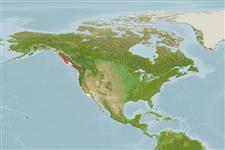>
Perciformes/Cottoidei (Sculpins) >
Cottidae (Sculpins)
Etymology: Artedius: Petrus (Peter) Artedi, (10 Mar.) 1705-35 (28 Sep.), a son of a clergyman from Anundsjö named Olaus Arctaedius, in the northern part of Sweden.In 1729 he changed his name from Arctaedius to Arctædi, a name still later simplified to Artedi (Ref. 45335); harringtoni: Named for Mark W. Harrington, President of the University of Washington (Ref. 6885).
More on author: Starks.
Environment: milieu / climate zone / depth range / distribution range
Ecologia
marinhas demersal; intervalo de profundidade 1 - 21 m (Ref. 2850). Temperate; 58°N - 32°N, 155°W - 118°W
Eastern Pacific: Kodiak Island, Alaska to San Miguel Island, southern California, USA.
Tamanho / Peso / Idade
Maturity: Lm ? range ? - ? cm
Max length : 10.0 cm TL macho/indeterminado; (Ref. 2850)
Espinhos dorsais (total): 9 - 10; Raios dorsais moles (total): 16-18; Espinhos anais 0; Raios anais moles: 10 - 14. Pelvic fins small.
Found in intertidal and subtidal rocky areas, around pilings (Ref. 2850). Males are territorial (Ref. 6885). Sexual dimorphism is remarkable (Ref. 74407). Males guard eggs (Ref. 74407).
Life cycle and mating behavior
Maturidade | Reprodução | Desova | Ovos | Fecundidade | Larvas
Males guard clutches of eggs and are quite territorial (Ref. 74407). The following account of mating behaviour comes from Ragland et.al. (1978): observed from an aquarium, courtship began 'when a gravid female approached a shelter occupied by a male. The male, which was not guarding eggs, responded by rolling its head in a circle and flaring the orange branchiostegal membranes. The cirri were not moved or deployed in any obvious fashion.
The female either ignored the male or responded by snapping the head horizontally several times in rapid succession and occasionally quivering. Once she entered the nest, the male often extruded its pene and performed bouts of a fanning display similar to those of other cottids (Ref. 205). The female left the nest shortly after laying eggs.'
Occurrence of intromission was not observed from this study due to technical problems. However, eggs stripped from gravid females developed and hatched after 11-15 days in the absence of a male, thereby supporting the hypothesis that internal fertilization had occurred.
Eschmeyer, W.N., E.S. Herald and H. Hammann, 1983. A field guide to Pacific coast fishes of North America. Boston (MA, USA): Houghton Mifflin Company. xii+336 p. (Ref. 2850)
Categoria na Lista Vermelha da IUCN (Ref. 130435)
Ameaça para o homem
Harmless
Utilização humana
Aquário: Aquários públicos
Mais informação
ReferênciasAquaculturaPerfil para aquaculturaEstirpesGenéticaElectrophoresesHereditariedadeDoençasProcessamentoNutrientsMass conversion
ColaboradoresFotografiasStamps, Coins Misc.SonsCiguateraVelocidadeTipo de nataçãoÁrea branquialOutras referênciasCérebrosVisão
Ferramentas
Relatórios especiais
Descarregue XML
Fontes da internet
Estimates based on models
Preferred temperature (Ref.
123201): 7.1 - 12.8, mean 10.1 °C (based on 178 cells).
Phylogenetic diversity index (Ref.
82804): PD
50 = 0.5312 [Uniqueness, from 0.5 = low to 2.0 = high].
Bayesian length-weight: a=0.00676 (0.00300 - 0.01523), b=3.17 (2.98 - 3.36), in cm total length, based on LWR estimates for this (Sub)family-body shape (Ref.
93245).
Nível Trófico (Ref.
69278): 3.4 ±0.52 se; based on food items.
Resiliência (Ref.
120179): Médio, tempo mínimo de duplicação da população 1,4 - 4,4 anos (Preliminary K or Fecundity.).
Fishing Vulnerability (Ref.
59153): Low vulnerability (10 of 100).
Nutrients (Ref.
124155): Calcium = 142 [51, 339] mg/100g; Iron = 0.46 [0.21, 1.08] mg/100g; Protein = 17.3 [15.0, 19.5] %; Omega3 = 0.602 [0.229, 1.706] g/100g; Selenium = 7.75 [3.04, 20.40] μg/100g; VitaminA = 35.5 [9.1, 131.4] μg/100g; Zinc = 0.973 [0.600, 1.752] mg/100g (wet weight);
